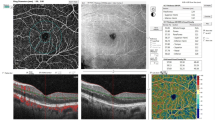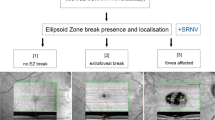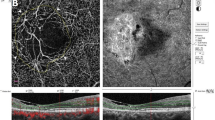Abstract
Purpose
To compare AngioTool (AT) vascular parameters (VP) between MacTel2 eyes and normal eyes. Secondary outcome measures were to correlate VP with BCVA and to analyze VP between various grades of Simple MacTel Classification.
Methods
This is a retrospective study. SD OCTA images of the superficial vascular complex (SVC) and deep capillary complex (DVC) were exported into Image J and AT. The explant area (EA), vessel area (VA), vessel percentage area (VPA), total number of junctions (TNJ), junction density (JD), total vessel length (TVL), average vessel length (AVL), total number of endpoints (TNE) and mean E lacunarity (MEL) were studied.
Results
Group 1 had 120 MacTel2 eyes. Group 2 had 60 age-matched normal eyes. All VP were significantly different between the two groups except EA and TNE in both complexes. None of the VP had a correlation with BCVA. Interquadrant analysis (IQA) in SVC and DVC showed statistical significance in VPA, AVL and JD and in AVL, TNE, JD, VPA respectively. Post hoc analysis in SVC and DVC showed statistical significance in TNJ, JD, TVL and AVL between grade 1 and grade 3, and in VA, VPA, TNJ, JD, TVL and MEL between grade 0 and grade 3 respectively.
Conclusion
VP were affected in MacTel2 eyes. VP did not correlate with BCVA. Occurrence of pigmentation is an important event in the progression of disease. AT may provide quantitative markers to measure disease progression.


Similar content being viewed by others
References
Gass JD, Oyakawa RT (1982) idiopathic juxtafoveolar retinal telangiectasis. Arch Ophthalmol 100:769–780. https://doi.org/10.1001/archopht.1982.01030030773010
Spaide RF, Klancnik JM, Cooney MJ (2015) Retinal vascular layers in macular telangiectasia type 2 imaged by optical coherence tomographic angiography. JAMA Ophthalmol 133:66. https://doi.org/10.1001/jamaophthalmol.2014.3950
Heeren TFC, Chew EY, Clemons T et al (2020) Macular Telangiectasia type 2: visual acuity, disease end stage, and the mactel area. Ophthalmology 127:1539–1548. https://doi.org/10.1016/j.ophtha.2020.03.040
Steinmetz JD, Bourne RRA, Briant PS et al (2021) Causes of blindness and vision impairment in 2020 and trends over 30 years, and prevalence of avoidable blindness in relation to VISION 2020: the right to sight: an analysis for the global burden of disease study. Lancet Glob Heal 9. https://doi.org/10.1016/S2214-109X(20)30489-7
Pauleikhoff D, Gunnemann F, Book M, Rothaus K (2019) Progression of vascular changes in macular telangiectasia type 2: comparison between SD-OCT and OCT angiography. Graefe’s Arch Clin Exp Ophthalmol 257:1381–1392. https://doi.org/10.1007/s00417-019-04323-0
Huang Y, Gangaputra S, Lee KE et al (2012) Signal quality assessment of retinal optical coherence tomography images. Investig Opthalmology Vis Sci 53:2133. https://doi.org/10.1167/iovs.11-8755
Zudaire E, Gambardella L, Kurcz C, Vermeren S (2011) A computational tool for quantitative analysis of vascular networks. PLoS One 6:e27385. https://doi.org/10.1371/journal.pone.0027385
Roisman L, Rosenfeld PJ (2016) Optical coherence tomography angiography of macular telangiectasia type 2. Dev Ophthalmol 56:146–58. https://doi.org/10.1159/000442807
Alex D, Giridhar A, Gopalakrishnan M et al (2021) Early spectral-domain optical coherence tomography biomarkers to confirm fellow eye changes in asymmetric type-2 macular telangiectasia. Retina 41:471–479. https://doi.org/10.1097/IAE.0000000000002954
Toto L, Di Antonio L, Mastropasqua R et al (2016) Multimodal imaging of macular telangiectasia type 2: focus on vascular changes using optical coherence tomography angiography. Investig Opthalmology Vis Sci 57:OCT268. https://doi.org/10.1167/iovs.15-18872
Ersoz MG, Hocaoglu M, SaymanMuslubas I et al (2020) Macular telangiectasia type 2. Retina 40:1132–1139. https://doi.org/10.1097/IAE.0000000000002510
Venkatesh R, Reddy NG, Mishra P et al (2022) Structural-vascular-functional correlation in type 2 non-proliferative macular telangiectasia. Int J Retin Vitr 8:59. https://doi.org/10.1186/s40942-022-00410-3
Peto T, Heeren TFC, Clemons TE et al (2018) Correlation of clinical and structural progression with visual acuity loss in macular telangiectasia type 2. Retina 38:S8–S13. https://doi.org/10.1097/IAE.0000000000001697
Pauleikhoff D, Bonelli R, Dubis AM et al (2019) Progression characteristics of ellipsoid zone loss in macular telangiectasia type 2. Acta Ophthalmol 97. https://doi.org/10.1111/aos.14110
Chew EY, Clemons TE, Jaffe GJ et al (2019) Effect of ciliary neurotrophic factor on retinal neurodegeneration in patients with macular telangiectasia type 2. Ophthalmology 126:540–549. https://doi.org/10.1016/j.ophtha.2018.09.041
Gass JD, Blodi BA (1993) Idiopathic juxtafoveolar retinal telangiectasis. Update of classification and follow-up study. Ophthalmology 100:1536–1546
Chandran K, Giridhar A, Gopalakrishnan M, Sivaprasad S (2022) Microvascular changes precede visible neurodegeneration in fellow eyes of patients with asymmetric type 2 macular telangiectasia. Eye 36:1623–1630. https://doi.org/10.1038/s41433-021-01699-4
Chew EY, Peto T, Clemons TE et al (2023) Macular telangiectasia type 2- a classification system using multimodal imaging mactel project report number 10. Ophthalmol Sci 3:100261. https://doi.org/10.1016/j.xops.2022.100261
Venkatesh R, Reddy NG, Mishra P et al (2022) Spectral domain OCT features in type 2 macular telangiectasia (type 2 MacTel): its relevance with clinical staging and visual acuity. Int J Retin Vitr 8:26. https://doi.org/10.1186/s40942-022-00378-0
Spaide RF, Yannuzzi LA, Maloca PM (2018) Retinal–choroidal anastomosis in macular telangiectasia type 2. Retina 38:1920–1929. https://doi.org/10.1097/IAE.0000000000002289
Funding
No funding was received for this research.
Author information
Authors and Affiliations
Corresponding author
Ethics declarations
Research involving human participants and/or animals
All procedures performed in studies involving human participants were in accordance with the ethical standards of the Institutional Ethics Committee of Aravind eye Hospital, Chennai, Tamilnadu, India (Project code : AEH/CHN/EC/DODNB/03/2022) and with the 1964 Helsinki declaration and its later amendments or comparable ethical standards.
Informed consent
Informed consent was obtained from all individual participants included in the study.
Consent of publication
The study or the data have not been published or presented elsewhere.
Conflict of interest
The authors have no financial and no conflict of interest.
Additional information
Publisher's Note
Springer Nature remains neutral with regard to jurisdictional claims in published maps and institutional affiliations.
Supplementary Information
Below is the link to the electronic supplementary material.
417_2024_6487_MOESM1_ESM.jpg
Supplementary file1 Supplementary Figure. SD OCTA image analysis of the deep vascular complex. a. Deep vascular complex (DVC) slab of eye with MacTel2, b. A specific ROI size of 1085*997□m was set for superior, inferior, nasal, and temporal with the edge of the ROI starting at the edge of the avascular zone. c. Cropped image with 4 quadrants d,e. Output image of the quadrants in Angiotool (AT) f. The results of the vascular parameters derived from the AT software. (JPG 297 KB)
417_2024_6487_MOESM2_ESM.docx
Supplementary file2 Supplementary table : Inter-quadrant analysis of vascular parameters in SVC and DVC in age matched healthy eyes. (DOCX 20 KB)
Rights and permissions
Springer Nature or its licensor (e.g. a society or other partner) holds exclusive rights to this article under a publishing agreement with the author(s) or other rightsholder(s); author self-archiving of the accepted manuscript version of this article is solely governed by the terms of such publishing agreement and applicable law.
About this article
Cite this article
Govindaraj, I., Mahalingam, M., Maheswari, U. et al. Quantification of vascular changes in macular telangiectasia type 2 with AngioTool software. Graefes Arch Clin Exp Ophthalmol (2024). https://doi.org/10.1007/s00417-024-06487-w
Received:
Revised:
Accepted:
Published:
DOI: https://doi.org/10.1007/s00417-024-06487-w




